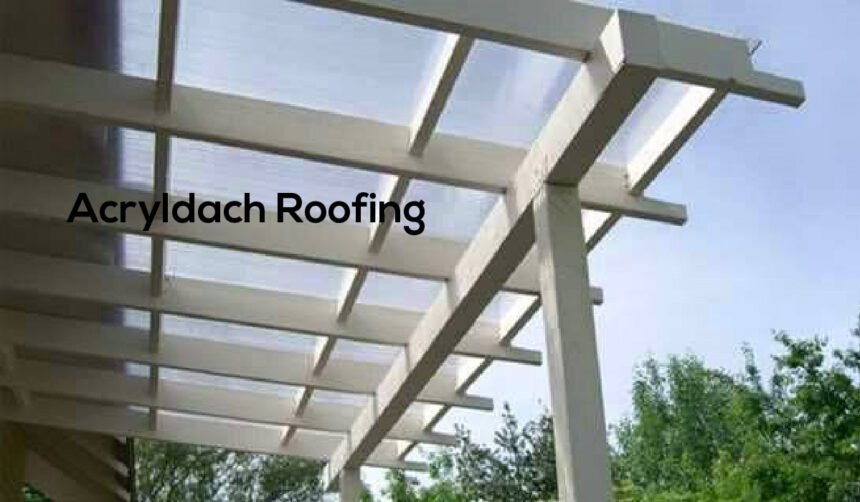What Is Acryldach?
Acryldach refers to a modern roofing system made from transparent acrylic sheets, also known as polymethyl methacrylate (PMMA). The term is a combination of two words: “acryl” meaning acrylic, and “dach”, the German word for roof. As a roofing material, Acryldach provides a rare blend of high light transmission, shatter resistance, and weather durability—making it an ideal solution for structures that require both protection and natural lighting.
Whether used for greenhouses, carports, commercial atriums, or outdoor patios, Acryldach allows architects and homeowners to achieve an aesthetically appealing, energy-efficient roofing system. Unlike traditional glass or metal roofing, Acryldach is significantly lighter in weight, easier to install, and highly resistant to UV radiation, which makes it suitable for long-term outdoor exposure without the risks of yellowing or degradation.
Introduction
The building industry has seen a significant shift toward lightweight, sustainable, and energy-efficient materials—and Acryldach perfectly aligns with this trend. As consumers and developers look for roofing systems that allow maximum daylight penetration, reduce electricity consumption, and withstand extreme weather conditions, acrylic roofing emerges as a front-runner. Not only does it outperform traditional materials in specific use cases, but it also adapts to modern architectural needs by offering customizability in color, thickness, and finish.
Acryldach meets the needs of diverse sectors—from residential home improvements to large-scale commercial and agricultural projects—thanks to its excellent strength-to-weight ratio and visual appeal. This article provides a complete overview of Acryldach: what it’s made of, where it’s used, how to install it, its advantages and limitations, and why it’s shaping the future of roofing systems.
The Material Behind Acryldach — What Is PMMA?
Origins of Acrylic in Architecture
The foundational material in Acryldach is PMMA (polymethyl methacrylate)—a transparent thermoplastic developed in the early 1930s. Originally used in aviation canopies, car headlamps, and optical lenses, PMMA proved its value in applications demanding both clarity and durability. As technology advanced, PMMA became more refined and entered the construction industry as an alternative to glass for windows, skylights, and eventually roofs. Its flexibility in shaping, cutting, and coating made it a highly desirable solution for designers looking to break away from the limitations of traditional roofing materials.
Key Physical and Optical Properties
PMMA used in Acryldach panels delivers exceptional transparency, often transmitting up to 92% of visible light—nearly equivalent to glass. It weighs only about half as much as glass, making it easier to transport and install. PMMA is also more impact-resistant than glass, reducing the risks of breakage or injury. Additionally, it possesses built-in UV resistance, especially when coated properly, which helps maintain optical clarity over decades. Acrylic roofing panels come in a range of thicknesses, finishes, and color tints, allowing users to tailor the material to their exact structural and design needs.
Types and Thickness of Acryldach Sheets
Common Forms
Acryldach panels are available in several formats, each suitable for different architectural purposes. Flat sheets are ideal for modern skylights or commercial canopies. Corrugated panels offer structural strength and efficient rainwater runoff, often used in carports and industrial sheds. Twin-wall and multi-wall sheets contain internal air gaps that significantly enhance thermal insulation, making them perfect for greenhouses or winter gardens where maintaining temperature is crucial.
Thickness Ranges
Standard Acryldach sheets vary between 2 mm and 16 mm in thickness. Thinner sheets (2–4 mm) are used for applications like window awnings or decorative panels, while 10–16 mm panels are suitable for load-bearing roofs or installations requiring higher insulation. The right thickness depends on climate, wind loads, and desired transparency.
Customization Options
Modern manufacturers offer acrylic roofing sheets with a variety of custom options. These include UV-blocking coatings, anti-scratch surfaces, anti-glare layers, and infrared reflective finishes that help in temperature regulation. You can choose from clear, opal, bronze, or grey-tinted panels, depending on the ambiance or light diffusion required.
Where Is Acryldach Used?
Residential Applications
Homeowners frequently choose Acryldach for carports, patios, sunrooms, and balconies, due to its ability to provide weather protection while maintaining a bright, open atmosphere. Greenhouses benefit from acrylic’s superior light transmission and UV filtering properties, which promote plant health and reduce the need for supplemental lighting.
Commercial & Public Spaces
Acryldach plays a vital role in shopping centers, cafés, bus stops, and urban walkways. It helps create inviting, naturally lit environments while shielding users from the elements. Restaurants especially favor Acryldach for outdoor dining covers that remain visually open yet functional.
Industrial & Agricultural Use
In industrial settings, Acryldach is commonly installed in factory skylights, production sheds, and storage units to reduce energy costs and increase safety. In agriculture, it supports nurseries, plant shelters, and hydroponic farms by offering durable, light-diffusing coverage.
Acryldach Applications by Sector
| Sector | Use Case | Key Benefit |
|---|---|---|
| Residential | Carports, greenhouses, skylights | Natural light, modern design |
| Commercial | Cafés, malls, bus stops | UV protection, cost-efficiency |
| Industrial | Warehouse skylights, workshops | Light diffusion, weatherproofing |
| Agricultural | Rain shelters, nurseries | Plant growth, climate control |
Pros and Cons of Acryldach
Advantages
One of the main advantages of Acryldach is its ability to maximize natural light while providing complete protection against rain, snow, and harmful UV rays. Its lightweight composition allows for faster and less costly installation. Being shatter-resistant, Acryldach provides safety for families and customers alike. Additionally, it’s customizable in terms of color, texture, and form, making it a favorite among modern designers. Its eco-friendly profile—being both recyclable and energy-saving—adds another compelling reason to consider Acryldach for both residential and commercial projects.
Disadvantages
Despite its many benefits, Acryldach is not without limitations. Acrylic is more prone to scratching than glass or polycarbonate unless coated. It also tends to expand or contract with temperature changes, which requires allowances during installation. While acrylic is more impact-resistant than glass, it does not match the toughness of polycarbonate, especially in extreme hail-prone areas. Additionally, single-layer panels offer limited insulation, though multi-wall designs can offset this weakness.
Acryldach vs Other Roofing Materials
Acrylic vs Glass vs Polycarbonate vs Metal
| Feature | Acryldach (Acrylic) | Glass | Polycarbonate | Metal Roofing |
|---|---|---|---|---|
| Weight | Light | Heavy | Light | Medium |
| Clarity | Excellent | Excellent | Moderate | Opaque |
| UV Resistance | High (with coating) | Moderate | Very High | Low |
| Impact Resistance | Good | Poor | Excellent | Good |
| Cost | Moderate | High | Higher | Low–Medium |
| Maintenance | Low | High | Moderate | High |
Installation Guide — How to Install Acryldach Roofing
Step-by-Step Process
Installing Acryldach begins with accurate measurement of the roofing area. A support frame made of aluminum, treated wood, or steel is constructed, ensuring it’s strong and level. Acrylic panels are then cut to size using fine-tooth saws and mounted using corrosion-resistant screws with rubber washers. It’s vital to leave thermal expansion gaps between the panels. Joints are sealed with UV-stable silicone, and edge trims or gutters are added as finishing touches to enhance function and appearance.
DIY vs Professional Installation
While DIY installation is possible for small roofs, such as patio covers or garden sheds, larger applications like greenhouses or commercial walkways should be handled by professionals to ensure safety, proper sealing, and warranty compliance.
Tips to Avoid Mistakes
Avoid overtightening screws, which can cause cracks. Never remove the protective film until after installation. Always use weather-rated sealants, and check for compatibility with acrylic materials to prevent chemical damage.
Maintenance and Care
Cleaning Tips
Acryldach requires minimal cleaning. Use lukewarm water, mild soap, and a soft cloth to remove dust and stains. Avoid harsh chemicals, rough sponges, or ammonia-based cleaners, which may dull the finish or cause cracks.
Scratch and Crack Repairs
Small scratches can be polished out using acrylic polish or car wax, while minor cracks can be sealed with PMMA-compatible adhesives. Deep gouges or cracked panels should be replaced to maintain waterproofing.
Long-Term Durability
A properly installed and maintained Acryldach system can last 15 to 30 years, with UV-coated panels maintaining clarity and strength far longer than untreated ones.
Environmental Impact & Sustainability
Energy Efficiency
Acryldach contributes to green building goals by reducing dependency on artificial lighting, especially in sunrooms, factories, and indoor gardens. Reflective or tinted panels can further reduce interior heat buildup, decreasing HVAC loads.
Recyclability
PMMA is a recyclable plastic, and many manufacturers offer recycled-content panels or take-back programs to help reduce environmental footprint.
Green Building Certifications
Using Acryldach can support LEED, BREEAM, and other eco-certifications, particularly in categories related to daylighting, energy performance, and material sustainability.
Real-World Examples of Acryldach Use
Urban Greenhouse in Zurich
A year-round rooftop greenhouse in Zurich uses double-wall Acryldach to maintain warmth during snowy winters while allowing full-spectrum daylight for crop growth.
Café Roof in Amsterdam
A trendy café in Amsterdam installed a retractable Acryldach system with UV-tinted panels, providing shade and comfort while enhancing the aesthetic charm of the outdoor dining area.
Covered Walkway in Berlin
In Berlin, a pedestrian bridge was fitted with an arched Acryldach canopy integrated with LED lighting and weather shielding, combining form and function in public design.
Future of Acryldach in Architecture
As architectural demands evolve toward sustainability, transparency, and modular design, Acryldach is poised to play a crucial role in future building projects. Expect further innovation with solar-integrated panels, smart tinting technology, and bio-based PMMA production, making Acryldach even more versatile and eco-friendly. Its role in prefab construction, zero-energy buildings, and vertical farming is likely to grow as urban development seeks smarter material solutions.
Buying Guide — How to Choose the Right Acryldach System
Selection Criteria
Choose based on:
-
Thickness and load requirements
-
UV and anti-scratch coatings
-
Color/tint preference
-
Warranty terms (ideally 10–25 years)
Estimated Cost Breakdown
| Feature | Budget Panels | Mid-Range | Premium |
|---|---|---|---|
| Price per m² | $10–$15 | $20–$30 | $40+ |
| UV Coating | Optional | Included | Advanced layers |
| Warranty | 5–10 years | 10–15 years | 20–25 years |
Conclusion
Acryldach offers a perfect harmony between performance and design, giving modern builders a material that is clear like glass, strong like polycarbonate, and light as plastic. With decades-long durability, low maintenance, and energy-saving properties, it is a top contender in roofing solutions for residential patios, greenhouses, commercial walkways, and eco-conscious public infrastructure. Whether you’re looking to enhance your home with a transparent patio cover or design a futuristic glass-like atrium, Acryldach gives you the tools to build with both form and function in mind.
FAQs About Acryldach
1. What is Acryldach used for?
Acryldach is used as a roofing material for carports, patios, greenhouses, skylights, and outdoor walkways. It allows natural light to pass through while protecting against rain, snow, and UV rays. This makes Acryldach perfect for bright, covered spaces.
2. How long does an Acryldach roof last?
An Acryldach roof can last between 15 to 30 years, depending on the thickness of the acrylic sheets, UV protection, and maintenance. High‑quality coated panels usually last longer without turning yellow or brittle.
3. Does Acryldach turn yellow in sunlight?
Modern Acryldach roofing does not turn yellow because most panels include UV‑resistant coatings. Older or low‑quality acrylic can discolor over time, so choosing high‑grade Acryldach is important for long‑term clarity.
4. Is Acryldach better than glass roofing?
Yes, Acryldach is often better than glass because it is lighter, shatter‑resistant, easier to install, and less likely to break. It still offers similar light transmission, making it a safer and more practical option for outdoor roofs.
5. Can you install Acryldach yourself?
Yes, you can install Acryldach yourself for small projects like patios or sheds. However, larger roofs should be installed by professionals to ensure proper sealing, drainage, and support, which helps the roofing last longer.
For More Information, Visit Celebritymagazine






